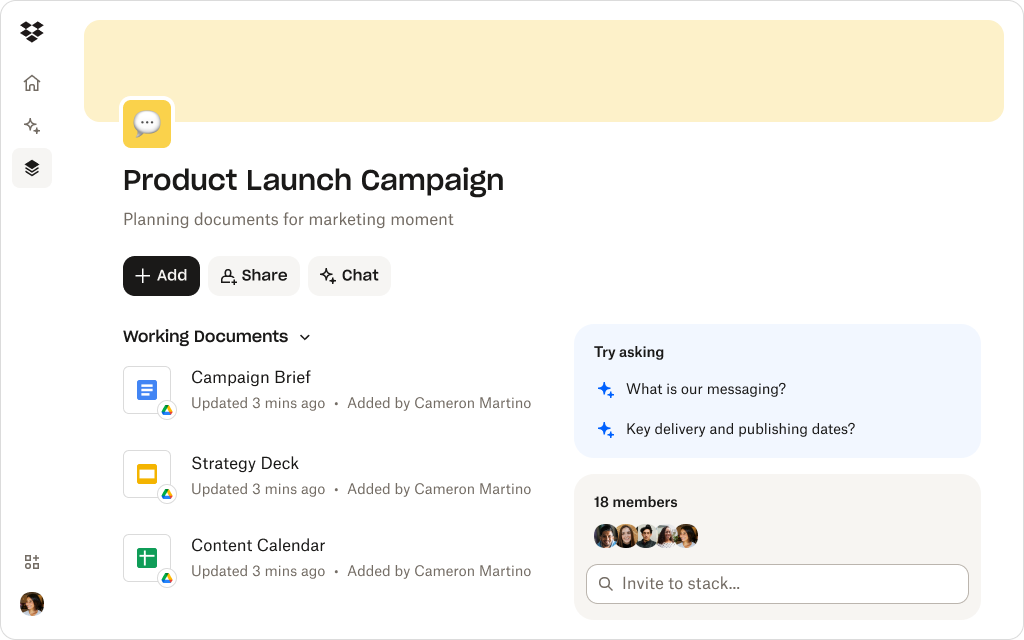
A strong campaign brief saves time, aligns teams, and turns ideas into action faster.
Every great campaign starts with clarity—and a shared plan.
A good brief keeps creative energy focused, connects teams around purpose, and prevents weeks of unnecessary rework. But too often, briefs get written, shared, and forgotten—living in folders instead of fueling collaboration.
Here’s how to write a campaign brief your team will actually use: one that’s clear, connected, and actionable from the first draft to the final deliverable.

Why most campaign briefs fail
Most campaign briefs don’t fail because teams lack talent—they fail because teams lack time and context. In the rush to kick things off, briefs are often written in isolation: a quick doc pulled together after a meeting, or a reused template missing lessons from previous work.
That’s how critical details slip through. Goals sound vague (“increase awareness”), target audiences blur, and creative direction gets lost in translation.
When briefs lack substance, creative teams start guessing—and every round of feedback becomes a round of re-alignment.
The real cost isn’t just slower approvals. It’s missed insights, duplicated effort, and campaigns that drift away from their original intent. A strong brief doesn’t just organize information—it builds shared understanding.
It connects past learnings, current goals, and creative vision in one place, so every stakeholder knows not just the what, but the why behind the work.
What a usable brief really looks like
A brief your team will use isn’t about length—it’s about clarity. It defines what success looks like, who you’re speaking to, and what motivates your audience. It gives creative teams confidence and stakeholders context.
Think of it as your campaign’s source of truth. Every element—from objectives to messaging to measurement—should link back to the same story: what are we trying to achieve, and why does it matter?
When a brief is clear, accessible, and connected to real data, teams naturally turn to it for direction rather than clarification.
Write it for the people doing the work, not just the people approving it. Keep it short enough to scan, detailed enough to guide decisions, and easy to update as projects evolve.
The key elements every brief should include
A great campaign brief balances detail with direction. It gives your team the structure they need without overwhelming them with noise.
These core elements create the foundation for a brief your team will actually reference—not just file away:
- Objectives: The measurable outcomes you want to achieve
- Audience: Who you’re speaking to and what they need
- Insight: What motivates them, drawn from past campaigns
- Deliverables and timing: What’s due, when, and from whom
- Success metrics: How you’ll know it worked
- References: Past campaigns, creative examples, and brand guidelines
A strong brief leaves no room for confusion but still gives teams creative space to explore. When structure and freedom coexist, your team can move quickly and stay aligned.
Example:
Weak: “Drive awareness of the new product.”
Strong: “Launch a three-week social campaign introducing the new product’s key feature set to existing customers, targeting a 15% lift in engagement.”
When direction is this clear, teams move faster and feedback loops shrink.
A brief your team will use doesn’t just list information—it connects ideas. When objectives link to insights, and insights link to deliverables, every contributor understands how their piece fits into the whole. That shared understanding is what turns a static document into a working tool your team will keep coming back to.
Turn your brief into a tool, not a document
A strong brief bridges vision and execution. Instead of listing broad ambitions, translate them into tangible actions and measurable outcomes.
For example, rather than saying “increase engagement,” define the path to achieve it: “Publish two how-to videos per week featuring user testimonials.”
Keep the brief close to where work happens so it can adapt as ideas evolve. When everyone contributes updates and feedback in one shared space, the brief becomes a reference point for alignment—not a static document forgotten after kickoff.

How Dash helps teams build smarter briefs
Dropbox Dash turns creative briefing into a connected, informed process. By linking your team’s collective knowledge, Dash helps every project start with context—not from a blank page.
Instead of starting from scratch, Dash brings your team’s history into every new project:
- Instant access to past work: Surface previous briefs, reports, and creative assets to see what’s worked before
- Integrated search: Find insights, performance data, or references across Dropbox, Google Drive, and connected tools—all from one workspace
- Stack organization: Group related files—briefs, drafts, and performance reports—into a single, searchable view
- Collaboration in context: If you’re using Dropbox, you can co-edit, comment, and review directly on the brief, with version history preserved
With Dash, your creative direction stays tied to the data and decisions that shaped it—so every brief evolves with your work, not apart from it.
Build better campaign briefs with Dash
Dash connects your past campaigns and brand assets so every new brief starts smarter.
Best practices for maintaining effective briefs
A great brief isn’t finished when it’s written—it’s finished when it’s used. The best teams treat briefs as living documents that evolve alongside their work.
Here’s how to keep yours active, useful, and relevant from planning to post-launch:
- Treat briefs as living documents. Update them as goals or insights evolve so they always reflect current priorities.
- Review before kickoff. Align everyone on objectives, timelines, and measures of success. When the team starts together, revisions shrink later.
- Archive every version. Keep learnings searchable so no one repeats past mistakes—and future campaigns start smarter.
- Keep context close. Store briefs with campaign assets, creative drafts, and notes. A brief only works when it lives where the work happens.
- Close the loop. Add performance results post-launch. The next brief should start with what this one taught you.
Briefs are only valuable if teams use them. Make them easy to find, quick to reference, and connected to real outcomes.
When everyone can see how their work ladders up to the bigger goal, your brief becomes more than a document—it becomes your team’s shared playbook.
Write stronger campaign briefs with Dropbox Dash
A brief should launch momentum—not confusion.
With Dropbox Dash, your team can surface past learnings, organize context, and create briefs that truly guide action. Dash understands your work—helping your team connect insights, files, and feedback all in one place.
From inspiration to iteration, Dash brings structure and creativity together so every campaign starts clear and ends strong.
When your briefs live where collaboration happens, they stop being static documents and start driving alignment, speed, and results. And when briefs stay active and actionable, your team stops treating them as reference docs—and starts using them as the foundation for every great idea.
When everyone understands the plan, great work follows naturally. Explore Dash features or try a demo.
Frequently asked questions
Dash brings your team’s history into every new project. It surfaces past briefs, creative assets, and performance insights so every document starts informed—not from scratch.
It helps you write briefs grounded in real data and brand voice.
Yes. Dash integrates directly with your Dropbox folders, keeping your existing hierarchy intact while making everything searchable and connected.
You get the power of AI without changing how your team already works.
Absolutely. Dash saves time by organizing references and streamlining brief creation, so even lean teams can plan faster and deliver more.
It’s like having a strategist, archivist, and project manager in one shared workspace.
Get started with Dash
.webp)

.svg)


